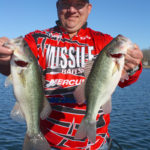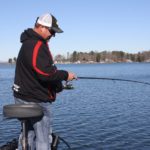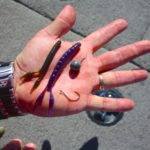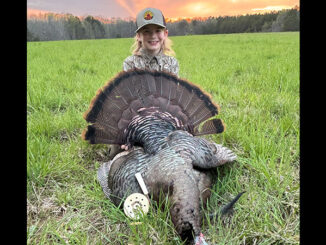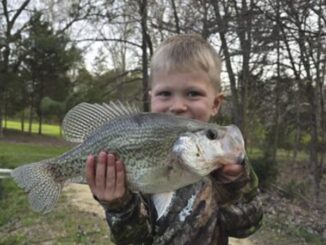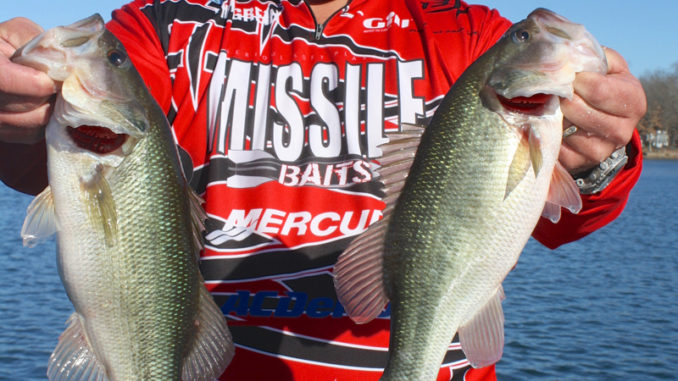
Drop-shotting will put bass in the boat at Belews Lake, where the water runs hot even in the winter.
When bass pro Tim Grein of Winston-Salem fishes Belews Lake, he approaches the 3,864-acre reservoir with a mindset that’s different from when he fishes most other North Carolina waters.
On other lakes, Brein routinely engages in tournament competition, where the financial stakes are high and the pressure to win is intense. Conversely, Belews Lake’s small size and limited facilities render it unsuitable for most major tournaments. Its 3,864 acres and 88 miles of undeveloped shoreline northeast of Winston-Salem and northwest of Greensboro are mostly fished by local bass clubs and area anglers.
So how did Grein, an avid tournament fisherman, come to fish Belews Lake?
“Rodney Sorrel of Stokesdale, a buddy of mine, asked me to go fishing with him at Belews Lake in December,” Grein said. “That trip took place years ago, and we went fishing just for fun.”
The Belews Creek Steam Station was a big reason behind the outing. The plant’s super-hot discharge creates a winter sauna for bass, fooling the fish into acting and biting like it’s spring. The “hot hole” has made Belews one of the state’s more productive winter lakes for bass.
Fun and fish aside, Grein had another idea that drove him to spend time on Belews.
“It was a place for me to practice drop-shotting in winter,” said Grein. “I heard that Belews was a clear, deep-water lake with depths over 100 feet in places, just the conditions I wanted. I had tried drop-shotting a little, but I wanted to experiment with knots, lines and baits. I also needed to fine tune my search skills with my electronics.
“What I learned at Belews, I could apply to smallmouth fishing in tournaments up north on lakes like Champlain.”
For those unfamiliar with drop-shot fishing, the technique is attributed to saltwater fishermen, who have used a variation of the basic rig for years. It gained a following among bass fishermen after California anglers adapted it for use in clear, deep western reservoirs.
Drop-shotting is a finesse technique for catching suspended bass in highly pressured waters using mainly spinning tackle, light line, small weights and hooks and soft-plastic baits.
The typical drop-shot rig consists of a hook tied to the main line so that it rests from 6 to 18 inches above the end of the line. A small weight is tied to the end of the line. A finesse worm is added to the hook either nose-hooked, Texas-rigged or rigged wacky style.
Grein employs a basic drop-shot rig with a few wrinkles of his own. He uses a 7-foot-3 medium-action 13 Fishing spinning rod with a high-speed spinning reel spooled with 10-pound braided P-Line tied a 6- to 8-foot leader of 6- to 8-pound fluorocarbon P-Line using a FG knot (See www.netknots.com).
“You don’t want a rod that’s too stiff with those little hooks, because you’ll tear the hooks out of the fish’s mouth,” Grein said. “The light leader is for less visibility in gin-clear water.”
Grein ties his hook to the leader so it rests 12 to 18 inches above the weight. His hook is a No. 1/0 Gamakatsu G-finesse drop-shot hook, his weight a 3/8- or 1/2-ounce round or cylindrical drop-shot weight. The round weight has a clip to hold the end of the line. The line can be jerked free of the clip should the weight snag.
Grein uses a San Diego double-jam knot to attach the hook to his line.
“Many anglers use a Palomar knot, but that knot will sometimes break with fluorocarbon line,” said Grein. “The San Diego double-jam knot has a knot-test strength of 94 percent compared to a knot test strength of 91 percent for the Palomar. The San Diego knot is more difficult to tie but worth the effort.”
For baits, Grein prefers the Missile Fuse 4.4 and the Missile Drop Craw. The Fuse is a slender, 4.4-inch straight worm with crawfish claws at its end, while the Drop Craw is a 3-inch crawfish-shaped worm specifically designed for drop-shot fishing that can be nose-hooked or Texas-rigged. He chooses the baits in green pumpkin and purple.
Other lure choices include small, ring-tail worms, straight-tail worms and finesse plastics.
Guide Joel Richardson of Kernersville, who considers Belews his home lake, employs a simplified drop-shot rig compared to Grein’s. He uses spinning tackle and 8-pound test line without any leader. He ties a No. 4 drop-shot hook 8 to 18 inches above his weight with a finesse worm impaled upon the hook. His 1/16- or 1/4-ounce round weight, regularly used by anglers targeting catfish, closely resembles a round, drop-shot weight.
Richardson offers this drop-shotting tip.
“Though I catch most of my fish drop-shotting vertically in 30 to 40 feet of water, I’ve also caught them in 5 feet of water by casting and dragging the drop-shot rig along a point like a Carolina rig,” he said.
Although drop-shotting gained acclaim for catching bass in western lakes during warm weather, it is a deadly winter technique at Belews.
“The best time for drop-shotting at Belews is from December through February,” Grein said. “The water temperature doesn’t get cold because of the steam plant. The ideal day is one with the air temperature in the 40s with only a slight wind. For the most part, drop-shot fishing is vertical fishing, and it’s hard to keep your boat positioned over the fish in a strong wind.”
Successful drop-shotting requires discipline.
“Don’t wet a hook until you locate fish and forage with your electronics,” Grein said. “The moment my boat hits the water, I turn on my Lowrance HDS 12 unit and adjust the sensitivity level. Lake waters vary in density, so sensitivity adjustments are important for clear readings.”
Fortunately, Belews’ small size makes electronic searches less painful during the winter. Better yet, the southern end, with its cooler, shallower water, can be ignored.
The search area stretches from mid-lake near the steam plant to the dam, featuring warm waters as deep as 130 feet.
As Grein searches, he looks for channel bends and long, steep points, especially points where the channel swings up to them. He expects to find fish in 25 to 30 feet of water, though that zone can vary.
“I’ve caught fish drop-shotting as deep as 65 feet at Belews,” said Grein. “Every day is a little bit different.”
Some deep-water structure harbors brush and stumps, which hold fish, but Grein doesn’t target the cover. If he happens to stumble upon it, so much the better. He’s mostly fishing for suspended fish that aren’t cover-oriented.
Grein idles around until he finds a large school of fish and forage. Baitfish appear as big balls on most depth finders; fish appear as arches. If Grein uses his down-imaging function, the fish look like dots. The best scenario involves seeing string images below the pods of baitfish. The strings indicate fish feeding upon baitfish. Grein calls it “the lasagna effect,” also known as “strings of spaghetti.”
If his depth finder shows baitfish on the bottom but no fish, Grein looks more closely at the screen.
“Baitfish can be so close to the bottom that fish images aren’t easily visible,” he said. “If you spy balls of shad, fish are usually nearby.”
Many fishermen immediately head for the hot hole where the water, sometimes reaching 94 degrees, is discharged from the Belews Creek Steam Station. The burst of hot water impacts surrounding waters, rising water temperatures into the 60s and 70s, even in bitter winter conditions.
“In all the years I’ve fished Belews, I’ve never seen the water temperature drop below 50 degrees, even in the coldest winter,” Richardson said.
The warm water has another benefit; it prevents winter die-offs of shad.
As expected, the hot hole receives heavy fishing pressure.
“That’s why I like to fish when the weather is nasty,” said Grein. “Not many fishermen are on the lake, and I can do what I want to.”
With fish located and the boat positioned over them, the proper presentation becomes critical. Drop-shotting mostly dictates a vertical presentation with the bait placed close to the fish.
Grein said bass often hit the lure as it falls. The strike is almost undetectable, but a fisherman can tell if a fish is on if his line moves to the side or if his line feels like mush. On a quality depth finder, the fishing line can be seen as its sinks in the water, and the fish can be seen swimming to the bait.
Grein shakes his bait once the weight hits the bottom or does nothing at all.
“The movement of water alone gives action to the bait, triggering a strike,” said Grein. “If you’re at the hot hole, the current gives action to the bait.”
Grein gives a spot five to 10 minutes to produce before leaving it. If he sees numbers of fish on his depth finder, he’ll stay longer and try downsizing his line and leader or changing weights to see if he can get the fish to hit. Belews Lake bass can be finicky because of the clear water — with visibility down to 6 to 10 feet — so downsizing can pay off.
Grein said the majority of winter bass run from 2 to 3 pounds, along with an occasional 4-pound fish. Big sacks are possible, though. This past December, Richardson won a Saturday tourney at the lake with more than 18 pounds of bass, all caught on a drop-shot rig.
Richardson said spotted bass have also found their way into Belews through unauthorized stockings by fishermen.
“I catch about as many spots now as I do largemouth,” he said.
Fish of any size are a plus, given the disrupted history of the fishery. Duke Power created Belews in 1973 to provide cooling water for the steam station, its largest coal-burning plant. The lake became a bass bonanza for fishermen during its first year of existence, then catastrophe struck. From 1974 to 1984, selenium, a wastewater by-product of the steam plant, leaked into the lake, causing deformities and reproductive failures in the fish. Nineteen of the lake’s 20 species were wiped out.
After scientists discovered the cause of the calamity in 1986, Duke Power changed its methods to halt the influx of selenium.As a result, Belews has slowly transformed from a bass cemetery into a productive winter bass fishery and a worthy drop-shot fishing hole.
DESTINATION INFORMATION
HOW TO GET THERE — Belews Lake is near Stokesdale and Pine Hall and straddles the border between Stokes, Rockingham, Guilford and Forsyth counties. It can be reached from NC 65 or US 158. Public boat access is at Piney Bluff off NC 65 and the Pine Hall Access off Pine Hall Road.
WHEN TO GO — The best months for catching bass on dropshot rigs are December through February.
BEST TECHNIQUES — Drop-shotting is most effective with light spinning gear and small, plastic finesse baits. A drop-shot rig is fished vertically after concentrations of fish and forage are found at points, humps and drops in 20 to 35 feet of water, though fish can be caught deeper. Electronics are essential for locating fish.
FISHING INFO/GUIDES — Carolina Marina, Stokesdale, 336-427-0498; Humphrey’s Ridge Campground Marina, Stokesdale, 336-427-3949; Joel Richardson, 336-643-7214, www.joelgrichardson.com. See also Guides and Charters in Classifieds.
ACCOMMODATIONS — Budget Inn, Madison, 336-548-6011; Humphrey’s Ridge Family Campground, 336-427-3949; Carolina Camp-in and Marina, 800-344-2628.
MAPS — Duke Energy, www.duke-energy.com/lakes/facts-and-maps/belews-lake.asp.

